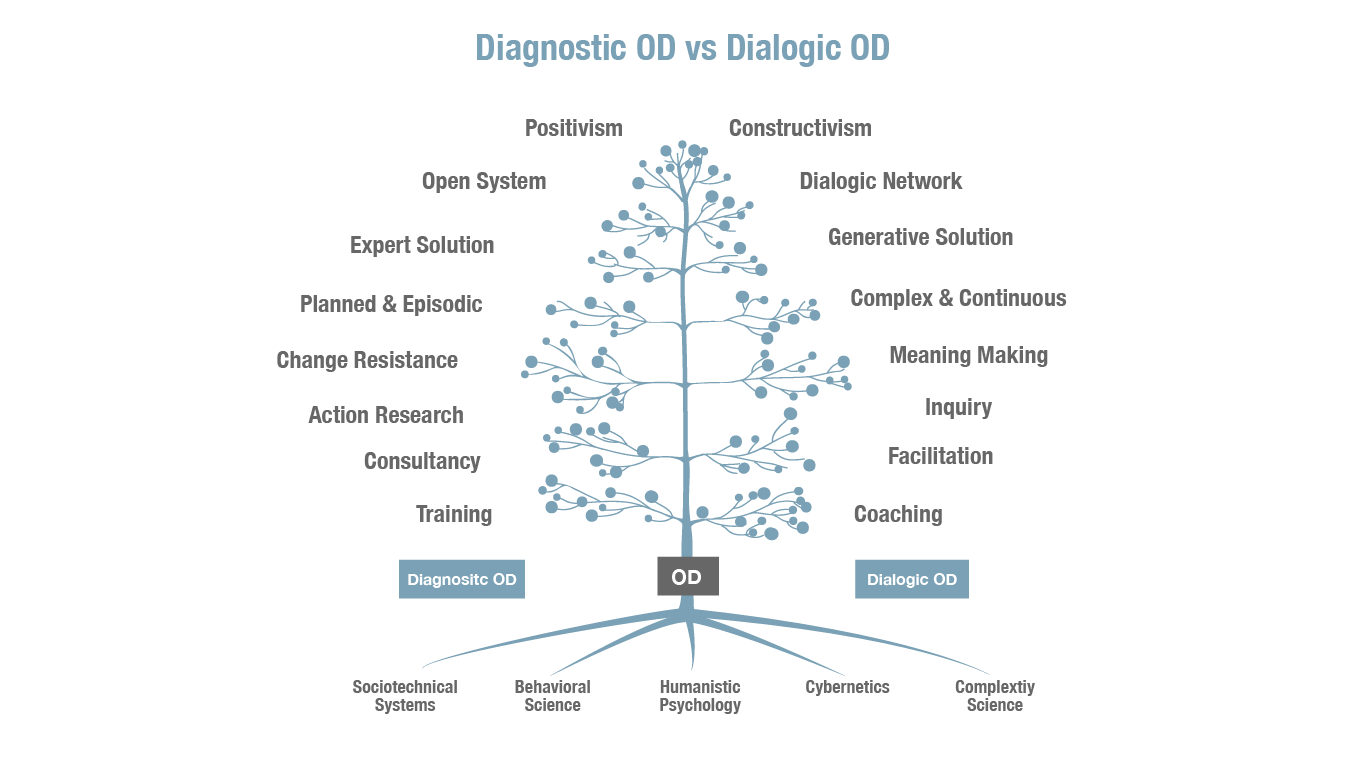Diagnostic OD vs Dialogic OD
Experienced OD practitioners use different OD interventions to develop organizations from good to great. There are two school of thoughts in organization development – Diagnostic OD and Dialogic OD

Diagnostic OD
Evolving since 1960’s, OD takes a diagnostic approach to analyze the organizational context and design OD interventions to make changes. OD professionals with a diagnostic OD mindset see organizations as an open system, which could be scientifically diagnosed through research to identify objective solutions and regard the change is episodic and can be planned. The solutions grounded from data analysis are often designed by experts or consultants. This kind of planned change interventions are effective for the management to drive the changes downwards in the organizations. However, the change efforts may face resistance to change.
Dialogic OD
Whereas, Dialogic OD has evolved since the mid 1980’s. OD professionals with a dialogic OD mindset see organizations as meaning-making systems, where the reality is socially constructed by their people (Bushe & Marshak, 2015). They believe in the context of complex environment; the linear approach of changes may not be effective to cope with the uncertainties. Adaptive ways to deal with challenges are needed. Dialogic OD approaches such as participative inquiry, engagement, and reflection are designed and facilitated to allow self-organizing in the group, which generates discourses, narratives, stories, images, and symbols to emerge patterns and meanings of the change.
Integral Perspective: Mixed Approach of OD
In our experience in various OD client projects, Integral design OD interventions with a right mix of Diagnostic OD and Dialogic OD Approach. Interventions are delivered through a mix of consultancy, training, facilitation, and coaching. In a recent OD project of sales partnership between a bank and an insurance company to improve their bancassurance performance, Integral adopted an OD intervention mixed with diagnostic and dialogic OD approaches. We diagnosed the expectation gaps through Depth Executive Interviews and Focus Groups. Based on the findings, we found an opportunity for the two management teams with a mindset shift from “Cannot Do” to “Can Do”, from “Confrontational” to “Collaborative”. Partnering with the Head of Sales, we facilitated Strategic Partnership Meetings mainly by World Café and Conflict Resolution Tools to resolve the conflicts and reach consensus onthe KPI and action plans. After 6 months, the sales performance was up significantly.
References
Arrow, A., McGrath, J., Berdahl, J. (2000). Small Groups As Complex Systems. USA: Sage Publications.
Bushe, G. R., & Marshak, R. J. (2015). Dialogic Organization Development: The Theory and Practice of Transformational Change. Oakland CA: Berrett-Koehler.
Dooley, K. (2004). Complexity Science models of Organizational Change and Innovation. In Poole, M and S Van de Ven (eds). Handbook of Organizational Change and Innovation (pp. 354-373). New York: Oxford University Press.
Eoyang, G., (2010). Human Systems Dynamics. In W. J. Rothwell, J. M. Stavros, R. L. Sullivan & A. Sullivan (Eds.), Practicing Organization Development (pp.465-475). USA: Pfeiffer.
Morgan, G. (2006). Images of Organization. USA: Sage Publications.
Olson, E. E., &Eoyang, G., H. (2001). Facilitating Organization Change. San Francisco: Jossey-Bass.
Snowden, D., & Boone, M. (2007). A Leader’s Framework for Decision Making of the circumstances they face. Harvard Business Review Journal.
